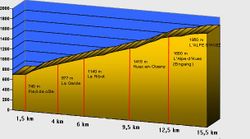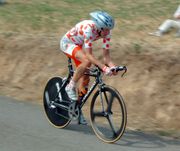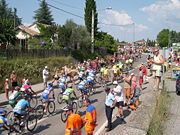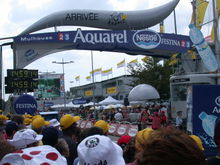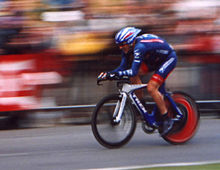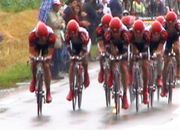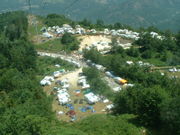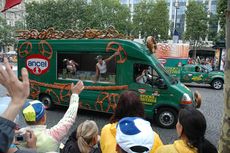Tour de France
2008/9 Schools Wikipedia Selection. Related subjects: Sports events
 |
|
|---|---|
| Tour de France | |
| Local name | Le Tour de France |
| Region | France and nearby countries |
| Date | July 7 to 29 ( 2007) |
| Type | Stage Race (Grand Tour) |
| General Director | Christian Prudhomme |
| History | |
| First race | 1903 |
| Number of races | 94 (2007) |
| First winner | |
| Most wins | |
| Latest winner | |
| Most career Yellow Jerseys | |
| Most career stage wins | |
The Tour de France started in 1903, and is is the world's biggest cycling race. It is a 22-day, 20-stage road race that is usually run over more than 3,000 km (1,864 mi). It is a circuit of most areas around France and, sometimes, neighbouring countries. The race is broken into stages from one town to another, each of which is an individual race. The time taken to complete each stage becomes a cumulative total to decide the outright winner at the end of the Tour.
Together with the Giro d'Italia (Tour of Italy) and Vuelta a España (Tour of Spain), the Tour de France is one of the three major stage races and the longest of the Union Cycliste Internationale (UCI) calendar. While the other two European Grand Tours are well known in Europe, they are relatively unknown outside the continent, and even the UCI World Cycling Championship is familiar only to cycling enthusiasts. The Tour de France, in contrast, has long been a household sporting name around the globe, even to those not generally interested in cycling.
As with most cycling races, competitors enter as part of a team. The race consists of 20 to 22 teams with nine riders each. Traditionally, entry is extended to invitation only, with invitations granted only to the best of the world's professional teams. The tour organizers recently have utilized UCI points (based upon team riders/results) to determine which teams would gain automatic entry into the tour and then typically reserve 2-4 team slots to at large teams or French continental teams who would not be able to race in the tour based upon their individual team results. Each team, known by the name of its sponsor, wears a distinctive jersey and riders assist one another and have access to a shared 'team car' (a mobile version of the pit crews in car racing).
History

The dominant sports newspaper in France at the end of the 19th century was Le Vélo. Like other sports papers, it mixed sports reports with news and political comment. France was split socially over the guilt or innocence of a soldier, Alfred Dreyfus, who had been found guilty of selling secrets to the Germans. Le Vélo stood for Dreyfus's innocence while some of its biggest advertisers, notably the owner of the Dion car works, believed him guilty. Angry scenes followed between the advertisers and the editor, Pierre Giffard, and the advertisers withdrew their support and started a rival paper.
It was to promote sales of the rival, L'Auto (spiritual but not actual predecessor to the present l'Équipe), that the Tour de France began. It was a publicity measure to outdo the Paris-Brest et retour race organised by Giffard. The idea for a round-France stage race came from L'Auto's chief cycling journalist, 26-year-old Géo Lefèvre. He and the editor, Henri Desgrange then discussed it after lunch at what is now the TGI Friday bar in Montmartre in Paris on November 20, 1902. L'Auto announced the race on January 19, 1903. The plan was for a five-week tour from May 31 to July 5; however, this proved too daunting, with only 15 entrants, so Desgrange cut the length to 19 days, changed the date to run from July 1 to 19, and offered a daily allowance which attracted 60 entrants, including amateur characters, some unemployed, some simply adventurous. It was these characters that helped catch the public imagination.
The demanding nature of the race (with the average length of the six stages being 400km the riders were sometimes expected to ride into the night), caught public imagination. The race was such a success for the newspaper that the circulation, which was 25,000 before the 1903 Tour, increased to 65,000 after it; by 1908 the race boosted circulation past a quarter of a million, and during the 1923 Tour it was selling 500,000 copies a day. The record circulation claimed by Desgrange was 854,000, achieved during the 1933 Tour.
Today, the Tour is organised by the Société du Tour de France, a subsidiary of Amaury Sport Organisation (ASO), which is part of the media group that owns L'Équipe.
Description
The Tour is a stage race, eachstage being a race one day. The time each rider takes to complete each stage is accumulated. Riders are often awarded time bonuses as well as their prize for finishing. Riders who finish in the same group are awarded the same time. Two riders are said to have finished in the same group if there is less than the length of a bike between them. A rider who crashes in the last three kilometres is given the time of the group in which he would have otherwise finished.
The ranking of riders by accumulated time is known as the General Classification. The winner is the rider with the least accumulated time after the final day.
It is possible to win overall without winning a stage, which Greg LeMond did in 1990. Winning a stage is considered more prestigious than winning most single day races. Although the number of stages has varied, the modern Tour has about 20 and a total length of 3,000 to 4,000 kilometres (1,800 to 2,500 mi). The shortest Tour was in 1904 at 2,420km, the longest in 1926 at 5,745km. The 2007 Tour was 3,569.9 km long. There are subsidiary competitions within the race (see below), some with distinctive jerseys for the best rider.
Today, the Tour is contested by teams backed by commercial sponsors and employing complicated tactics, but Desgrange originally insisted his competitors ride as individuals, even if they had sponsorship. He penalised slipstreaming and other tactics and accepted their inevitability only from the 1920s. Even when commercial teams had become commonplace in other events, the Tour was contested by national teams from 1930 to 1961 and again in 1967 and 1968, in both cases because the organisers felt sponsors were detracting from sporting purity.
Most stages take place in France though it is common to have stages in nearby countries, such as Italy, Spain, Switzerland, Belgium, Luxembourg, Germany, the Netherlands, Ireland, and Great Britain (visited in 1974 and 1994 and start of the 2007 tour). The three weeks usually includes two rest days, sometimes used to transport riders long distances between stages.
In recent years, the Tour has sometimes been preceded by a short individual time trial (1 to 15km) called the prologue. Since 1975, the finish of the Tour has been on the Champs-Élysées in Paris, the only time the avenue is closed other than for the processions of Bastille Day and for the Paris Marathon. Before 1975, the race finished at the Parc des Princes stadium in western Paris and at the Piste Municipale.
Stages of the Tour can be flat, undulating or mountainous. They are normally contested by all the riders starting together with the first over the line being the victor, but they can also be run against the clock for individuals or teams. The time-trials often have a significant effect because they separate riders by substantial margins, whereas in some conventional stages the participants finish together or in a few large groups. The overall winner is almost always a master of the mountains and time trials rather than the more straightforward flat stages.
The race alternates between clockwise and counter-clockwise circuits of France. For example, 2005 was clockwise — visiting the Alps first and then the Pyrenees — while 2006 went in the opposite direction. For the first half of its history, the Tour was a near-continuous loop, often running close to France's borders. Rules to restrict drug-taking have, since the 1960s, limited the overall distance, the daily distance and the number of days raced consecutively, and the modern Tour skips between one city or one region and another.
A feature almost from the start has been stages in the mountains. The roads are now good but at first they were tracks of hard-packed earth on which riders frequently had to push their bicycles. Even into the 1950s and 1960s, the road at the summit could be potholed and strewn with small rocks, and falls and serious injuries were common.
Mountain passes such as the Tourmalet in the Pyrenees have been made famous by the Tour de France and attract large numbers of amateur cyclists every day in summer, anxious to test their speed and fitness on roads used by the champions. The physical difficulty of climbs is established in a formula that rates a mountain by its steepness, its length and its position on the course. The easiest climbs are graded 4, most of the hardest as 1 and the exceptional (such as the Tourmalet) as unclassified, or "hors-catégorie".
Some recur almost annually. The most famous hors-catégorie peaks include the Col du Tourmalet, Mont Ventoux, Col du Galibier, the climb to the ski resort of Hautacam, and Alpe d'Huez.
The combination of endurance and strength needed to complete the Tour led the New York Times to say in 2006 that the "Tour de France is arguably the most physiologically demanding of athletic events." The effort was compared to "running a marathon several days a week for nearly three weeks", while the total elevation of the hill climbs was compared to "climbing three Everests."
Tour directors
- 1903 to 1939 Henri Desgrange
- 1947 to 1961 Jacques Goddet
- 1962 to 1986 Jacques Goddet and Félix Lévitan
- 1987 to 1988 Jean-François Naquet-Radiguet
- 1988 to 1989 Jean-Pierre Courcol
- 1989 to 2005 Jean-Marie Leblanc
- 2005 to present Christian Prudhomme
Famous stages
Since 1975, the final stage finishes on the Champs-Élysées in Paris, which is cobbled, making it difficult to cycle, though not as hard as the Paris-Roubaix. The race takes multiple turns over the avenue, which is lined with enormous crowds. This stage is not usually competitive in terms of the overall lead since it is flat and the leader is likely to have a sufficient margin to be unchallengeable. There have been exceptions, however. In 1987, with the Irish rider Stephen Roche leading the Spaniard Pedro Delgado by only 40 seconds, Delgado broke away from the peloton on the Champs-Élysées, threatening to snatch victory at the last minute. In the end he was caught. He and Roche both finished in the peloton, and Roche thereby won the Tour.
In 1989 the organizers returned to holding a time trial as the final stage. In it, Greg LeMond of the United States overtook the Frenchman Laurent Fignon, who held a 50-second lead, to win by eight seconds, the closest margin in the Tour's history.
The particularly tough climb of Alpe d'Huez is a favourite, providing a stage finish in most Tours. In 2004, in another experiment, the mountain time trial ended at Alpe d'Huez. This seems less likely to be repeated, following complaints from the riders of abusive spectator behaviour. Another famous mountain stage is the climb of Mont Ventoux, often claimed to be the hardest in the Tour due to the harsh conditions. The Tour usually features only one of these two climbs in a year.
To host a stage start or finish brings prestige and business to a town. The prologue and first stage are particularly prestigious. Usually one town will host the prologue (which is too short to go between towns) and also the start of stage 1. In some years, like 2005, there is no prologue. In 2007 the Tour director Christian Prudhomme stated that "in general, for a period of five years we have the Tour start outside of France 3 times and within France 2 times." In addition, the first few stages often go into a neighbouring country.
Prize money
Prize money has always been awarded, starting with the first Tour in 1903. From 20,000 francs the first year, the total prize money has increased each year. Prizes and bonuses are awarded according to the classification in each stage and the overall classifications at the end of the race. A smaller amount is paid to teams as a participation expense or a presence bonus. In 2006, a total of over €3,000,000 ($4,100,000) was awarded, the winner of the individual general classification receiving €450,000 ($600,000). Notwithstanding these increasing amounts, the importance of the prize money has decreased through the years, as riders are well paid by their employers - the cycling teams - by contract.
Classification jerseys
Apart from winning the Tour, each race has three further classifications: the points, the mountains and the best young rider. The leaders of the four competitions wear a distinctive jersey next day. Jerseys are awarded in a ceremony after each stage, sometimes before trailing riders have finished. When a single rider is entitled to more than one jersey, he wears the most prestigious and the second-placed rider in the other classification wears the jersey. For example, in the first week it is common for the overall classification (yellow jersey) and points (sprint) competition (green jersey) to be led by the same rider. In this case the leading rider will wear the yellow jersey and the rider placed second in the points competition will wear the green jersey.
The Tour's jersey colours have been adopted by other cycling stage races, and have thus come to have meaning within cycling generally, rather than solely in the Tour. For example, the Tour of Britain has yellow, green, and polka-dot jerseys with the same meaning as in the Tour de France. The Giro d’Italia differs in awarding the overall leader a pink jersey, having been organized and sponsored by La Gazzetta dello Sport, an Italian sports daily newspaper with pink pages.
Overall leader
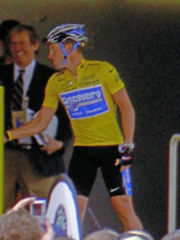
The maillot jaune (yellow jersey), which is worn by the general classification (or overall time) leader, is the most prized. It is awarded by calculating the total combined race time up to that point for each rider. The rider with the lowest total time is the leader, and at the end of the event is declared the overall winner of the Tour.
The winner of the first Tour de France wore not a yellow jersey but a green armband. There is doubt over when the yellow jersey began. The Belgian rider Philippe Thys, who won the Tour in 1913, 1914 and 1920, recalled in the Belgian magazine Champions et Vedettes when he was 67 that he was awarded a yellow jersey in 1913 when the organiser, Henri Desgrange, asked him to wear a coloured jersey. Thys declined, saying making himself more visible in yellow would encourage other riders to ride against him.
He said:
- "He then made his argument from another direction. Several stages later, it was my team manager at Peugeot, (Alphonse) Baugé, who urged me to give in. The yellow jersey would be an advertisement for the company and, that being the argument, I was obliged to concede. So a yellow jersey was bought in the first shop we came to. It was just the right size, although we had to cut a slightly larger hole for my head to go through."
He spoke of the next year's race, when "I won the first stage and was beaten by a tyre by Bossus in the second. On the following stage, the maillot jaune passed to Georget after a crash."
The Tour historian Jacques Augendre called Thys "a valorous rider... well-known for his intelligence" and said his claim "seems free from all suspicion". But: "No newspaper mentions a yellow jersey before the war. Being at a loss for witnesses, we can't solve this enigma."
Desgrange added the yellow jersey in 1919 because he wanted the race leader to wear something distinctive and because the pages of his newspaper, L'Auto, were yellow. Additional time bonuses, in the form of a number of seconds to be deducted from the rider's overall time, are available to the first 3 riders to finish the stage or cross an intermediate sprint (see below). As of 2005, the first 3 places to finish are awarded bonuses of 20, 12, and 8 seconds respectively, while the first 3 places at intermediate sprints are awarded 6, 4, and 2 seconds. However, these bonuses are rarely significant enough to cause major upset in the classement géneral (General Classification).
Sometimes a rider takes the overall lead during a stage and gets sufficiently far ahead of the yellow jersey wearer that his current lead is greater than his time deficit to the yellow jersey in the general classification; when this happens, this rider may be referred to as being "the yellow jersey on the road". Obviously, no jerseys can be exchanged in this situation, which is why in some other languages the leading rider is referred to as the "virtual yellow".
Points classification
The maillot vert (green jersey) is awarded for sprint points. At the end of each stage, points are earned by the riders who finish first, second, etc. Points are higher for flat stages, as sprints are more likely, and less for mountain stages, where climbers usually win.
Flat stages: 35, 30, 26, 24, 22, 20, 19, 18, 17, 16, 15, 14, 13, 12, 11, 10, 9, 8, 7, 6, 5, 4, 3, 2 and 1 points are awarded to the first 25 riders across the finish.
Medium-mountain stages: 25, 22, 20, 18, 16, 15, 14, 13, 12, 11, 10, 9, 8, 7, 6, 5, 4, 3, 2, 1 points are awarded to the first 20 riders across the finish.
High-mountain stages: 20, 17, 15, 13, 12, 10, 9, 8, 7, 6, 5, 4, 3, 2, 1 points are awarded to the first 15 riders across the finish.
Time-trials: 15, 12, 10, 8, 6, 5, 4, 3, 2, 1 points are awarded to the top 10 finishers of the stage.
Intermediate sprints: 6, 4, and 2 points are awarded to the first three finishers.
In case of a tie, the number of stage wins determine the green jersey, then the number of intermediate sprint victories, and finally, the rider's standing in the overall classification.
King of the Mountains
The " King of the Mountains" wears a white jersey with red dots (maillot à pois rouges), referred to as the "polka dot jersey" and inspired by a jersey that the former organiser, Félix Lévitan saw while at the Vélodrome d'Hiver track in Paris in his youth. The competition is calculated by points awarded to the first riders at the top of designated hills and mountains, the greatest number of points being awarded for the hardest ascents.
Climbs rated "Hors Catégorie" (HC): 20, 18, 16, 14, 12, 10, 8, 7, 6 and 5 points for the first 10 riders to the summit.
Category 1 climbs: 15, 13, 11, 9, 8, 7, 6 and 5 points for the first 8 riders to the top.
Category 2 climbs: 10, 9, 8, 7, 6, and 5 for the first 6 riders to the top.
Category 3 climbs: 4, 3, 2 and 1 points for the first 4 riders to the top.
Category 4 climbs: 3, 2 and 1 points for the first 3 riders to the top.
NOTE: For the last climb of a stage, the points are doubled (for HC, Cat 1 and Cat 2 climbs only).
In case of a tie, the rider with the most HC wins takes the jersey, then the rider with the most Cat 1 wins, etc...
Although the best climber was first recognised in 1933, the jersey was not introduced until 1975.
Other classifications
There are three lesser classifications, though only one awards the leader a jersey. The maillot blanc (white jersey) is for the best-placed rider less than 25 years old on January 1 of the year the Tour is ridden.
The "prix de combativité" goes to the rider who has done most to animate the day's racing, usually by trying to break clear of the field. It is decided by a panel of experts. The most combative rider of a stage wears a number printed white-on-red instead of black-on-white in the next stage. At the end of the Tour, an award is given to the rider thought to be the most aggressive throughout the entire tour.
The team prize is assessed by adding the times of each team's best three riders each day. The competition does not have its own jersey but since 2006 the leading team has worn numbers printed black-on-yellow instead of black-on-white. The number of riders in a team has varied but is now normally nine. Until 1930, teams represented countries, groups of countries or French regions. From 1930, but with the exception of 1967 and 1968 when there was a return to geographical teams, riders have been entered by commercial teams.
As in all road races, national and world champions wear not their ordinary team colours but their world or national championship jerseys when competing in the appropriate race: the time-trial champion in the time-trial, the road race in massed stages.
Historical jerseys
Previously, there was a red jersey for the standings in non-stage-finish sprints: points were awarded to the first three riders to pass two or three intermediate points during the stage. These sprints also scored points towards the green jersey and bonus seconds towards the overall classification, as well as cash prizes offered by the residents of the area where the sprint took place. The sprints remain, with all these additional effects, the most significant now being the points for the green jersey. The red jersey was abolished in 1989.
There was also a combination jersey, scored on a points system based on standings for the yellow, green, red, and polka-dot jerseys. The design was a patchwork, with areas resembling each individual jersey design. This was abolished in the same year as the red jersey.
Stages
Mass-start stages
In an ordinary stage, all riders start simultaneously and share the road. The real start ( départ réel) usually is some 2 to 5 kilometres (1 to 3 mi) away from the starting point, and is announced by the Tour director in the officials' car waving a white flag.
Riders are permitted to touch (but not push or nudge) and to shelter behind each other, in slipstream (see drafting). The rider who crosses the finish line first wins. In the first week of the Tour, this often leads to spectacular mass sprints.
While only finishers are awarded sprint points, all riders finishing in an identifiable group (with no significant gap to the rider in front, as determined by race officials) are deemed to have finished the stage in the same time as the lead rider of that group for overall classification purposes. This avoids what would otherwise be dangerous mass sprints. It is not unusual for the entire field to finish in a single group, taking some time to cross the line, but being credited with the same time as the stage winner.
Time bonuses are awarded at some intermediate sprints and stage finishes to the first three riders who reach the specified point. These bonuses generally are a maximum of 20 seconds, and can allow a good sprinter to qualify for the yellow jersey early in the Tour.
Riders who crash within the last 3 kilometres of the stage are credited with the finishing time of the group that they were with when they crashed . This prevents riders from being penalised for accidents that do not accurately reflect their performance on the stage as a whole given that crashes in the final kilometre can be huge pileups that are hard to avoid for a rider farther back in the peloton. A crashed sprinter inside the final kilometre will not win the sprint, but avoids being penalised in the overall classification. The final kilometre is indicated in the race course by a red triangular pennant - known as the flamme rouge - raised above the road.
Some ordinary stages take place in the mountains, almost always causing major shifts in the General Classification. On ordinary stages that do not have extended mountain climbs, most riders can manage to stay together in the peloton all the way to the finish; during mountain stages, however, it is not uncommon for some riders to lose 40 minutes to the winner of the stage. The so called mountain stages are often the deciding factor in determining the winner of the Tour de France. With the exception of the now traditional finish at the Champs-Elysées all famous stages, like Alpe d'Huez and Mont Ventoux, are mountain stages, and these often bring out the most spectators who line up the roads by the thousands to cheer and encourage the cyclists and support their favorites.
Individual time trials
In an individual time trial each rider rides individually. The first stage of the tour is often a short time trial known as a prologue. The prologue is to decide who wears yellow on the opening day, and provide a spectacle for the organising city.
There are usually three or four time trials during the Tour. One may be a team time trial (see below). Traditionally the final time trial has been the penultimate stage, and effectively determines the winner before the final ordinary stage which is not ridden competitively until the last hour. On a few occasions, the race organisers made the final stage into Paris a time trial. The most recent occasion on which this was done, in 1989, yielded the closest ever finish in Tour history, when Greg LeMond beat Laurent Fignon by eight seconds overall. Fignon wore the yellow jersey for the final stage, with a lead of 50 seconds, and was beaten by LeMond's superior time trial performance. LeMond's unusual handlebars which placed his forearms close together and reduce wind resistance, and his streamlined helmet, were considered a factor in his victory.
Team time trial
| 2nd: 20" | 12th: 2' 00" |
| 3rd: 30" | 13th: 2' 10" |
| 4th: 40" | 14th: 2' 20" |
| 5th: 50" | 15th: 2' 30" |
| 6th: 1' | 16th: 2' 35" |
| 7th: 1' 10" | 17th: 2' 40" |
| 8th: 1' 20" | 18th: 2' 45" |
| 9th: 1' 30" | 19th: 2' 50" |
| 10th: 1' 40" | 20th: 2' 55" |
| 11th: 1' 50" | 21st: 3' 00" |
Often in the first week of the Tour there is a team time trial (TTT), in which each team rides together without interference from competing teams. The team time is determined by the fifth rider to cross the line; all riders ahead of the fifth rider, and those finishing within one bike length of each other, are awarded this same time. Riders who finish more than one bike-length behind their respective teams are awarded their own individual times.
The TTT has been criticized for strongly favoring strong teams and handicapping strong riders in weaker teams. To address this criticism, the 2004 and 2005 editions of the Tour limited the maximum team time difference relative to the fastest team, according to the team rankings on the stage. The following table indicates the maximum time penalty added to the winning team's time that a team will receive, according to its team time placing. However, this does not apply to riders finishing behind their own teams, and does not protect riders in case of crashing in the last kilometre, unlike during normal stages.
For example, a team that finishes in 14th place, six minutes behind the winning team, would lose only two minutes and 20 seconds in the General Classification relative to the winners of the TTT. If the team time had been 2:13 behind the winning team, then the team time will be 2:13 assuming that this were still the 14th place.
The most recent TTT was held in 2005.
Culture
The Tour is popular and important for the cycling fans in France and in Europe. Millions of spectators line the route every year, some having camped a week in advance to get the best views. A recognizable part of the crowd each day is Didi Senft who, dressed in a red devil costume, has been known as the Tour de France devil or El Diablo since 1993. The inspiration for the costume is attributed to the final kilometre of each Tour stage, indicated by a red triangle suspended over the road.
In the hours before the riders pass, a carnival atmosphere prevails. Any amateur cyclist is free to attempt the course on his bicycle in the morning, after which begins a garish cavalcade of advertising vehicles blaring music and tossing hats, souvenirs, sweets and free samples . As word passes that the riders are approaching, the fans sometimes encroach on the road until they are an arm’s length from the riders.
Customs
The riders temper their competitiveness and enthusiasm with an elaborate but unwritten code of conduct. When possible, a rider is allowed to lead the race through his home village or on his birthday. It is considered unsporting to attack a leading rider delayed by a mechanical breakdown or other misfortune, one who is eating in the feed zone or one who is satisfying un besoin naturel (roughly translated to "a natural need", referring to urinating). Not sticking to these customs can lead to animosity. Unless the final stage is a time trial, or the gap between the top two is extremely close, riders generally do not attack on the final stage, leaving the leader to bask in the glory of winning.
The rider ranked last in the general classification, who may wind up in Paris with an overall time five or more hours slower than that of the winner, is called the lanterne rouge. Such was the sympathy shown to the last rider in the past that he could command higher fees in other races than riders who finished better. This custom has died along with the round-the-houses races once run off all over France in the weeks after the Tour.
Terminology
Much of the terminology used to describe the Tour de France is used in bicycle racing across the world. Terms specific to the Tour de France include:
- Flamme rouge ("red kite")
- The red pennant hanging as close as possible to a kilometre from the finish.
- Lanterne rouge
- Meaning "red lantern" (as found at the end of a rail train), the name for the overall last-place rider.
- Voiture balai
- The "broom wagon" follows the race to collect riders who cannot continue. Some riders prefer to be picked up by their team's car instead. Riders are generally expected to finish the race within 10–12 percent of the winner’s time or risk being dropped from the tour.
Films
A casual fan, Scott Coady attended the 2000 Tour de France with the aim to follow the entire Tour de France with a handheld video camera. By chance, he got a press accreditation and went on to make The Tour Baby! which has gained cult status among cyclists. He made the film to benefit the Lance Armstrong Foundation raising more than $160,000 for the foundation.
In 2005, two films chronicled the efforts of a single team competing in the Tour de France. The German film Höllentour, translated as " Hell on Wheels" in English, records the Tour in 2003, the centenary year, from the perspective of Team Telekom. The film was directed by Pepe Danquart who won an Academy Award for Live Action Short Film in 1993 for Black Rider (Schwarzfahrer). Also released was Danish film Overcoming by Tómas Gislason, which records the 2004 Tour de France from the perspective of Team CSC.
One of the most famous films about the Tour is Vive Le Tour by Louis Malle. This 18 minute short takes a humorous look at the 1962 edition. The 1965 Tour was filmed by Claude Lelouch in Pour un Maillot Jaune. This 30 minute documentary contains no narration and relies on the sights and sounds of the Tour itself.
A movie based on Lance Armstrong's career is currently in a pre-production stage.
- Höllentour at the Internet Movie Database
- Overcoming at the Internet Movie Database
- Vive Le Tour at the Internet Movie Database
- Pour un Maillot Jaune at the Internet Movie Database
In fiction, the plot of the 2003 animated feature "Les Triplettes de Belleville" ( The Triplets of Belleville) ties into the Tour De France.
- Triplettes de Belleville, Les at the Internet Movie Database
Music
In 1983, the German music group Kraftwerk released the single Tour de France which was described as a minimalistic "melding of man and machine". The single was later included on a Kraftwerk record dedicated to the race, the Tour de France Soundtracks album from 2003.
Doping
Allegations of doping have plagued the Tour almost since its beginning in 1903. Early Tour riders were said to have consumed alcohol and used ether, among other substances, as a means of dulling the pain of competing in endurance cycling. As time went by, riders began using substances as a means of increasing performance rather than dulling the senses, and organizing bodies such as the Tour and the International Cycling Union ( UCI), as well as government bodies, enacted policies to combat the practice.
On July 13, 1967, British cyclist Tom Simpson died climbing Mont Ventoux following use of amphetamines, complicated by the now defunct practice of drinking as little as possible. His now-supposed last words, "put me back on my bike", were invented by Sid Saltmarsh of the British magazine Cycling and the daily paper " The Sun".
At the 1998 Tour de France, dubbed the "Tour of Shame", a doping scandal erupted when Willy Voet, one of the soigneurs for the Festina team, was arrested for possession of erythropoietin (EPO), growth hormones, testosterone and amphetamines. French police raided several teams in their hotels and found doping products in the possession of the TVM team. The riders staged a sit-down strike on stage 17. After mediation by Jean-Marie Leblanc, the director of the Tour, police agreed to limit the most heavy-handed tactics and the riders agreed to continue. Some riders and teams had already abandoned and only 96 riders finished the race. In a 2000 criminal trial, it became clear that the management and health officials of the Festina team had organised the doping.
In the years following the Festina scandal, further anti-doping measures were introduced by race organizers and the UCI, including more frequent testing of riders and new tests for blood doping ( transfusions and EPO use). A new, independent organization, the World Anti-Doping Agency (WADA), was also created. Evidence of doping has however persisted. In 2002, the wife of Raimondas Rumšas, third in the 2002 Tour de France, was arrested by French police after EPO and anabolic steroids were found in her car. Rumšas, who had not failed a doping test, was not penalised. In 2004, Philippe Gaumont, a rider with the Cofidis team, told investigators and the press that doping with various substances was endemic to the team. Fellow Cofidis rider David Millar confessed to EPO use. In the same year, Jesus Manzano, a rider with the Kelme team, described in detail how he had allegedly been forced by his team to use banned substances.
Doping controversy has surrounded seven-time Tour champion Lance Armstrong for some time, although there has never been evidence sufficient for him to be penalized. In late August 2005, one month after Armstrong's seventh consecutive victory, the French sports newspaper l'Équipe claimed to have uncovered evidence that Armstrong had used EPO in the 1999 Tour de France. Armstrong denied using EPO and the UCI did not penalise him. In response to the L'Equipe allegations, an investigation was begun by the UCI in October 2005. The investigation reported that Armstrong did not engage in doping and that the actions of the World Anti-Doping Agency were "completely inconsistent" with testing rules. At the same 1999 Tour, Armstrong's urine showed traces of a glucocorticosteroid hormone, although the amount detected was well below the “positive” threshold. Armstrong explained that he had used the skin cream Cemalyt containing triamcinolone to treat saddle sores. Armstrong had previously received permission from the UCI to use this skin cream for his saddle sores.
The 2006 Tour had been plagued by the Operación Puerto doping case before its beginning, when many favorites, such as Jan Ullrich and Ivan Basso, were banned by their teams one day prior to the Prologue due to doping allegations. Seventeen riders were implicated. Then, the most serious doping charge in Tour history emerged just four days after the end of the 2006 Tour de France: it was announced that the American rider Floyd Landis had a positive test for a testosterone imbalance in his 'A' or initial test sample, after he won stage 17; this was confirmed in his 'B' sample result, published on August 5, 2006. The decision to strip Landis of the victory rests with the International Cycling Union, but Tour de France director Christian Prudhomme said, "It goes without saying that for us Floyd Landis is no longer the winner of the 2006 Tour de France". Landis has stated that he will fight to clear his name.
At a press conference on May 24, 2007, Erik Zabel admitted using EPO during the first week of the 1996 Tour de France, when he won the overall maillot vert (green jersey). Following a plea from Zabel for former cyclists to admit to using drugs, former Tour de France winner and manager of Team CSC, Bjarne Riis admitted at a press conference in Copenhagen on May 25, 2007 that he used EPO regularly from 1993 to 1998, including during his 1996 Tour de France win. His admission means the top three finishers in the 1996 Tour have all been linked to doping, with two admitting to cheating. Riis is the second Tour de France winner to confess the use of doping, following the example of Bernard Thevenet (winner in 1975 and 1977).
On 24 July 2007 Tour de France rider Alexander Vinokourov tested positive for a banned blood transfusion ( Blood doping) after winning a time trial, prompting his Astana team to pull out and police to raid the hotel of the team.
On 25 July 2007 it was announced that rider Cristian Moreni tested positive for testosterone. His Cofidis team pulled out as a result.
On 25 July 2007 the Tour leader Michael Rasmussen of Denmark was removed from the race for "violating internal team rules" by missing random drug tests on 9 May and 28 June. At first, he was punished with three administrative warnings, after Rasmussen had claimed to have been in Mexico visiting his wife's family without notifying his team about his whereabouts. On 25 June, the Italian journalist Davide Cassani told on Danish television that he had seen Rasmussen training in Italy when Rasmussen had claimed to be in Mexico. The alleged lying prompted his firing by the Rabobank team manager, Theo de Rooij.
On 20 September 2007, 2006 winner Floyd Landis was found guilty of doping by an arbitrator's ruling. He was stripped of his 2006 title, and received a two-year ban from cycling.
Deaths
- 1910: French racer Adolphe Helière drowned at the French Riviera during a rest day.
- 1935: Spanish racer Francisco Cepeda died after plunging down a ravine on the Col du Galibier.
- 1967: July 13, Stage 13: English rider Tom Simpson died of heart failure during the ascent of Mont Ventoux. Amphetamines were found in Simpson's jersey and in his blood. His death prompted officials to accelerate drug testing.
- 1995: July 18, stage 15: Italian racer Fabio Casartelli crashed at approximately 88 kmh (55 mph) descending the Col de Portet d'Aspet. Casartelli hit his head on a concrete block and died on the scene. He did not have a helmet, although the race doctor who attended to him maintains that it is unlikely one would have saved him as it would not have protected the part of his head that hit the concrete block.
Apart from the deaths of riders, another four fatal accidents have also occurred.
- 1957: July 14, motorcycle rider Rene Wagter and his passenger Alex Virot, a journalist for Radio-Luxembourg, slipped on gravel and went off a road without barriers in the mountains near Ax-les-Thermes.
- 1958: An official, Constant Wouters, died after an accident with sprinter André Darrigade during the final stage of the tour at the Parc des Princes.
- 2000: A 12-year-old from Ginasservis known as Phillippe was hit by a car in the Tour de France publicity caravan.
- 2002: A seven-year-old boy, Melvin Pompele, died near Retjons after running in front of the caravan.
Statistics
One rider has won seven times:
- Lance Armstrong (USA) in 1999, 2000, 2001, 2002, 2003, 2004, and 2005 (seven consecutive years).
Four other riders have won five times:
- Jacques Anquetil (France) in 1957, 1961, 1962, 1963 and 1964;
- Eddy Merckx (Belgium) in 1969, 1970, 1971, 1972 and 1974;
- Bernard Hinault (France) in 1978, 1979, 1981, 1982 and 1985;
- Miguel Indurain (Spain) in 1991, 1992, 1993, 1994 and 1995 (the first to do so in five consecutive years).
Three other riders have won three times:
- Philippe Thys (Belgium) in 1913, 1914, and 1920;
- Louison Bobet (France) in 1953, 1954, and 1955;
- Greg LeMond (USA) in 1986, 1989, and 1990.
The youngest winner was Henri Cornet aged 19 in 1904. Next youngest was Romain Maes aged 21 in 1935.
The oldest winner was Firmin Lambot aged 36 in 1922. Next oldest were Henri Pelissier ( 1923) and Gino Bartali ( 1948) both 34.
Gino Bartali holds the longest time span between titles, having earned his first and last Tour victories 10 years apart (in 1938 and 1948).
Riders from France have won most (36), followed by Belgium (18), United States (10), Spain (10), Italy (9), Luxembourg (4), Switzerland and the Netherlands (2 each) and Ireland, Denmark and Germany (1 each).
One rider has won the points competition six times:
- Erik Zabel (Germany) 1996, 1997, 1998, 1999, 2000 and 2001 (consecutive years)
One rider has won the King of the Mountains seven times:
- Richard Virenque (France) in 1994, 1995, 1996, 1997, 1999, 2003 and 2004.
Two riders have won the King of the Mountains six times:
- Federico Bahamontes (Spain) in 1954, 1958, 1959, 1962, 1963, 1964
- Lucien van Impe (Belgium) in 1971, 1972, 1975, 1977, 1981, 1983
One rider has won the King of the Mountains, the points competition, and the Tour in the same year:
- Eddy Merckx (Belgium) in 1969. Merckx would also have won the award for best young rider had it been conducted in that year; that competition was not initiated until 1975.
The most appearances have been by Joop Zoetemelk with 16 and no abandonments. Three riders ( Lucien van Impe, Guy Nulens and Viatcheslav Ekimov) have made 15 appearances; van Impe and Ekimov finished all 15 whereas Nulens abandoned twice.
